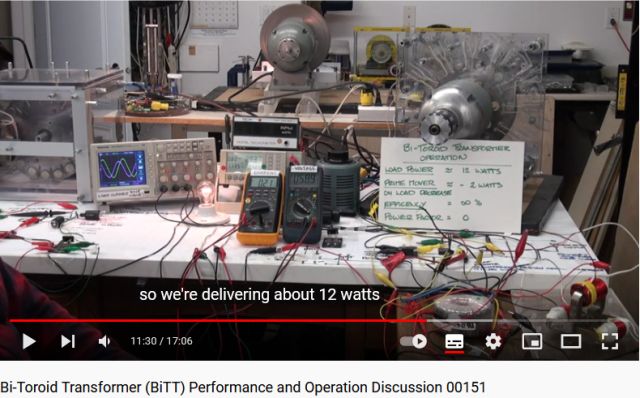US 9,230,730 BiTT - Bi-Toroid Transformer
by
Thane C. Heins

INFINITE EFFICIENCY BI TOROID TRANSFORMER vs CONVENTIONAL TRANSFORMER at OTTAWA UNIVERSITY June 2009
INFINITE EFFICIENCY (INFINITE OU) BI-TOROID DEMO aT OTTAWA UNIVERSITY - July 11, 2009.mov
INFINITE EFFICIENCY (INFINITE OU) Bi-Toroid Transformer (BiTT) vs CONVENTIONAL TRANSFORMER
INFINITE EFFICIENCY Bi-Toroid Transformer Operating with Zero PF Dec 7, 2014
JLN Labs France BiTT v2 0 Replication and Performance Validation
JLN Labs France BiTT v2 1 Replication Powered in DC for EV Chargers
Create the Future Design Contest Bi-Toroid Transformer (BiTT) Load Isolation Transformer
Demo # 5 Bi-Toroid Transformer at Infinite Efficiency (00084)
Bi-Toroid Transformer (BiTT) Performance and Operation Discussion 00151
Thane C Heins BiTT Replication Part 1 - Tim Tron
Thane C Heins BiTT Replication BEMF Test Part 2 - Tim Tron
Thane C Heins BiTT Replication Part 3 - Tim Tron
Thane C Heins BiTT Replication Part 4 - Tim Tron
BiTT core with curved shunt bars made of soft steel florist wire - MrDKONZEN
The gap-solution to make power from BiTT shunt-bar windings - MrDKONZEN
BiTt shunt bar winds now make power when split into two coils with gap between - MrDKONZEN
Two of the four shunt-bar windings gives 80ma in and 410ma out. (just testing currents) - MrDKONZEN
More BiTT testing and theories as to why - MrDKONZEN
BiTT phase shift on scope - MrDKONZEN
Out of phase BiTT - use FWBR to flip itself to be all in phase? - MrDKONZEN
more tests - MrDKONZEN
BiTT vs Conventional Transformer (Maxxsonics)
BiTT vs Conventional Transformer 2 (Maxxsonics)
39C Bitoroid For HV Resonant Drive Transformer, Tune and Testing
Part 1 3ph transformer core BiTT construction - MrDKONZEN
Part 2 winding preparation and winds on primary leg - MrDKONZEN
Part 3: Preparing to wind secondaries, construction details - MrDKONZEN
Part 4:. winding secondaries and some mistakes to avoid - MrDKONZEN
Part 5: connecting coil wires "series adding" - MrDKONZEN
Part 6: BiTT coils finished - MrDKONZEN
Part 7: Winds around shunt bars - MrDKONZEN
Part 8:. "Big Blue" BiTT finished, ready to test - MrDKONZEN
Testing Big Blue BiTT with 40W appliance bulbs as load - MrDKONZEN
BiTT core with curved shunt bars made of soft steel florist wire - MrDKONZEN
..703W out .422W in BiTT with two separate outputs to resistive loads - MrDKONZEN
BiTT on scope: 64 degree phase shift: .15W input .76W output - MrDKONZEN
120V input to BiTT; 25.5W IN, 38.6W OUT - MrDKONZEN
3ph transformer fixed up no shunt bars! 23.5W input 28.7 output - MrDKONZEN
24W input 82W output 230Vac input to BiTT - MrDKONZEN
314Vac input to BiTT 28W input 159W output, 83.5 degree phase angle! - MrDKONZEN
314Vac Input to BiTT gives 155W output from a 9W input with 88 degree phase shift - MrDKONZEN
Part 1: Laminate steel shunt bars made from scratch for new BiTT transformer - MrDKONZEN
Part 2: Shunt bars from laminate steel plates - MrDKONZEN
Part 3: Stacking the laminate plates, laminate skirt overhangs - MrDKONZEN
Part 4:New BiTT Finished, with lots of questions attached - MrDKONZEN
NewBiTT test 20W input 68W output - MrDKONZEN
NewBiTT: 3.49W input, 19W out - MrDKONZEN
NewBiTT transformer 110ohm load gives 86.4 degree phase shft - MrDKONZEN
First tests with 12vdc to 120Vac invertor 29W in 20W out not so good scope trace crazy looking - MrDKONZEN
rotating disc invertor running NewBiTT - MrDKONZEN
BiTT invertor powered ideas and tests whole lotta talk 21 minutes - MrDKONZEN
BiTT transformer powering a rotovertor AC motor. 165 degree phase shift. - MrDKONZEN
Brand new BiTT transformer "42-12-24" finished and tested. - MrDKONZEN
Retest of 421224 BiTT transformer; 5ohm load gives 26.8W back to grid - MrDKONZEN
rotating disc invertor down to .8 amps input to BiTT - MrDKONZEN
scoping watts in vs out BiTT invertor - MrDKONZEN
12uf AC cap across primary of BiTT drops amps input from 620ma to 150ma! - MrDKONZEN
12uf HV AC cap in SERIES from 120V grid to primary of BiTT gives 46W in 74W out - MrDKONZEN
10uf series AC cap gives 39W in and 68W out. with .39PF, and 120V input with 111 ohm load - MrDKONZEN
13uf series AC cap to "thick BiTT" primary yields 76.2W out from 45.6W in. - MrDKONZEN
Black Sand shunt bars for the BiTT transformer. - MrDKONZEN
Testing of black sand shunt bars in the BiTT transformer. - MrDKONZEN
New smaller size blacksand shunt bars behaving. - MrDKONZEN
X 3 overunity with 13uf cap in series to primary of BiTT with black sand shunt bars - MrDKONZEN
X 4 overunity with 40.2 ohm load from BiTT transformer with black sand shunt bars - MrDKONZEN
New 3ph transformer no shunt bars being tested. - MrDKONZEN
Comparison of black sand shunt bars vs galvanized steel laminates and testing problems. - MrDKONZEN
20W IN 76W OUT with 20 ohm load and 20uf AC cap in series - MrDKONZEN
new blacksand shunt bar BiTT transformer 7.8W in 22.5W out - MrDKONZEN
32W in 58W out black sand shunt bars w/374 ohm load 120V input. - MrDKONZEN
New BiTT project with AIR GAP in middle of primary core leg (!) - MrDKONZEN
3ph transformer with airgap in primary core leg tested. - MrDKONZEN
30.4W IN 44W OUT from 3ph transformer w/airgap in middle of primary core leg. - MrDKONZEN
New BiTT with chopped E core shunt bars and air gap in primary core leg. - MrDKONZEN
Cap placement condundrum with the new BiTT and circuit drawings. - MrDKONZEN